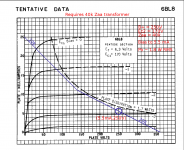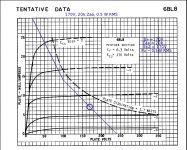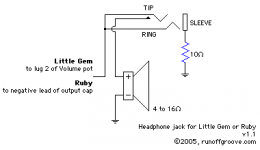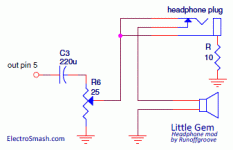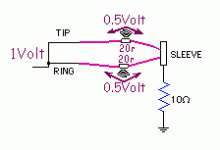Nice one Gnobuddy, though we have 230V AC here, but i guess in keeping with the spirit of such a project i might be able to find a transformer to step that down to around 120V. Looks like the 12C5 is a little tricky to come by though, but that might just be a matter of scouring the interweb.
On another note, Jaycar.co.uk has this line transformer: 5W Line Speaker Transformer | Jaycar UK Site, which supports 0.5W (this comes to 20K primary impedance as you mentioned). It only goes to 5W though, any tubes out there that fit that power level in Push pull? I don't need much to be honest, Ruby is plenty loud for most of my use and thats closer to 1W, if even that...
On another note, Jaycar.co.uk has this line transformer: 5W Line Speaker Transformer | Jaycar UK Site, which supports 0.5W (this comes to 20K primary impedance as you mentioned). It only goes to 5W though, any tubes out there that fit that power level in Push pull? I don't need much to be honest, Ruby is plenty loud for most of my use and thats closer to 1W, if even that...
There are relatively inexpensive 230:115 and 115:230 mains isolation transformers available. If you want, you could probably use one of those....we have 230V AC here...
As an example, here is the Triad N68-X ( N-68X Triad Magnetics | Mouser Canada ). It has two windings on the primary side, which you can wire in series for 230V AC mains, and in parallel for 115V AC mains. Either way, you get nominally 115V AC out of the secondary.
I was a bit worried about that. I also think the All American Five radios were a North American phenomenon, with their deadly-dangerous wiring (direct to AC mains, with no isolation transformerLooks like the 12C5 is a little tricky to come by
But here is where you need someone with a longer history with valves than I have - I know next to nothing about the history of European valves. But I would think there might be some at least similar valves there, perhaps used in radios or TVs, that will run on rather low B+, and cope with relatively low impedance loads.
I found it very interesting that the Jaycar page actually mentions the primary impedance, and doesn't just list the power taps. I've never seen that for similar transformers sold in North America.5W Line Speaker Transformer | Jaycar UK Site, which supports 0.5W (this comes to 20K primary impedance as you mentioned).
At any rate, this solves the difficulty of finding 12C5s! Using a Zaa=20k transformer immediately drops the AC anode current to one-sixth as much as you'd have with a 3.3k OT. You no longer need to have valves that can spit out lots of current at low B+.
The increased Zaa also drops power six-fold for the same B+ voltage. This means that as long as you don't go nuts with the supply voltage, your < 5W requirement is also easily met.
Agreed. The last valve guitar amp I built spit out a mighty 200 mW or so - barely enough to heat up a quarter-watt resistor! And it is quite loud enough for apartment use, as long as it's connected to an actual guitar speaker.Ruby is plenty loud for most of my use and thats closer to 1W, if even that...
On the Aussie Guitar Gearheads Forum, a prolifically creative member by the name of Darryl Hoy posted a 2-watt push-pull valve guitar amplifier using a pair of 6DX8 valves. This would have been about ten years ago, but Google might turn up some more details.
I designed and built a little push-pull guitar amp myself a few years ago, using a pair of 6AK6 pentodes, a 22.5k output transformer, and around 225V B+. It puts out somewhere around 2 or 3 watts.
More generally, the output power from a push-pull valve amp is roughly Po = 2*(B+ - 50)^2 / Zaa, where Po is in watts, B+ in volts, and Zaa in ohms. The "50" is an approximation for the voltage lost in the output pentode even when it is biased to maximum current.
So, given your possible 20,000 ohm (Zaa) transformer, you can calculate an approximate B+ voltage you need to deliver, say 2 watts output power. You can then use just about any pair of pentodes, and you'll get roughly the power you wanted.
Of course, if you use a pair of 6L6 or KT88, you'd be wasting most of their power potential (and a ton of cash). So it would make a lot more sense to use some little pentodes designed to drive the loudspeaker in a TV or radio.
-Gnobuddy
That'd be this thread, for those playing at home.On the Aussie Guitar Gearheads Forum, a prolifically creative member by the name of Darryl Hoy posted a 2-watt push-pull valve guitar amplifier using a pair of 6DX8 valves. This would have been about ten years ago, but Google might turn up some more details.
Speaking of major contributors, Rob Robinette has also been getting into the low(ish) power amp thing, with a range of PP and SE 12AU7 variations on classic Fender (and related) amps. Look for the word "Micro" on his amp page
Thanks for the link! Google didn't turn it up, and as I accidentally lost my login to my AGGH account some years ago, I couldn't use the forum's own search funciton.That'd be this thread, for those playing at home.
I found a few You Tube clips, and some of those amps didn't sound very good to me.Rob Robinette...low(ish) power...PP and SE 12AU7 variations
I wonder if using output triodes (instead of pentodes) has anything to do with it - I've read claims that output triodes distort too softly and progressively to sound right in a guitar amp. But I have no personal experience on this front, so this is essentially just hearsay.
I should add the caveat that most of the demos I found were made by people with negligible guitar-playing skills, which makes it harder to tell what the amp itself sounds like.
IMO that's a curse that plagues people who design DIY guitar amps - the typical builder is likely to have far better skills with his soldering-iron than with his guitar-pick!
-Gnobuddy
Based on the discussions herein (particularly the effect of rail sag on screen voltage and the "knee" ) I'd say so. But I'm in a similar spot.I wonder if using output triodes (instead of pentodes) has anything to do with it - I've read claims that output triodes distort too softly and progressively to sound right in a guitar amp. But I have no personal experience on this front, so this is essentially just hearsay.
The next amp will have a convertible PP AB output stage (similar to Duncan's Blues 112) I haven't looked but I imagine that there's some youtube clips of that amp out there somewhere. Subject to the caveats you list
I hadn't explored this possibility before, so I plotted a few load-lines to see what they looked like.Push-pull 6BL8...
The 6BL8 is generously rated for max. anode voltage, but max. anode current is quite limited, to only about 22mA at 30 volts anode voltage (the top left corner of the curves.) High voltage and low current requires a high load impedance.
On paper, then, a pair of these wants an OT with a 40k anode-to-anode primary impedance (see attached image.) Which is very high indeed, and I've never found an off-the-shelf transformer that can get this high.
Note that 40k Zaa translates to each pentode "seeing" a load of 20k for small signal excursions when both pentodes are operating, and seeing a load of 10k for bigger signal swings, when the other pentode has cut off.
If one could obtain this very special OT, then a pair of 6BL8 are estimated to produce about 1.8 watts RMS of output power, running on a B+ of 250 volts, and biased to about 5.5 mA idle current for each output valve.
In practice? Evidently people have managed to make these valves work with available (i.e. much lower) OT primary impedances. I couldn't find any load lines that looked reasonable on paper, but reality trumps on-paper estimates.
I would imagine the associated penalty would be much lower maximum power output (which might not be a penalty, if 1.8 watts is louder than desired.)
The last valve guitar amp I put together (on a bread-board) used an even smaller triode-pentode valve, a 6JW8. Single ended, it worked with a 22k reverb transformer and put out about 200 mW (which was plenty loud enough for me for use in my apartment.) Push-pull would have required an OT with roughly 45k Zaa, which I don't have, so I didn't try it.
-Gnobuddy
Attachments
Last edited:
I found something (barely) workable using a 20k OT and push-pull 6BL8 pair, but most of the tubes operating area is left unused, overdrive tone is suspect (because the load line passes above the "knee" at top left), and output power is drastically reduced to about half a watt.
B+ is 170 volts, which is conveniently obtained from a 1:1 mains isolation transformer and silicon diode rectifiers in North America. Each pentode is biased to 7 mA anode current.
-Gnobuddy
B+ is 170 volts, which is conveniently obtained from a 1:1 mains isolation transformer and silicon diode rectifiers in North America. Each pentode is biased to 7 mA anode current.
-Gnobuddy
Attachments
Thanks Gnobuddy. I got my 6BL8 tubes free from a garage clean out, and my 100volt line trafo for 12.5 cents (10 used for $1.25 on eBay)
And it sounds loud thro' a 12" guitar speaker.
Unusually, my 5w transformers have a .33 watt tap - boosting impedance to 32k(?)
I also have a SE 6BL8 bedroom amp using the same transformer without any apparent current saturation problems. And it has great overdrive tones - either directly into a speaker cabinet, or thro' the simple line out as a pedal before a big amp. This one is a keeper.
And it sounds loud thro' a 12" guitar speaker.
Unusually, my 5w transformers have a .33 watt tap - boosting impedance to 32k(?)
I also have a SE 6BL8 bedroom amp using the same transformer without any apparent current saturation problems. And it has great overdrive tones - either directly into a speaker cabinet, or thro' the simple line out as a pedal before a big amp. This one is a keeper.
I have no trouble believing you on this. Using the stock 10" speaker in my '65 Princeton Reverb reissue, my 200 mW single-ended amp, set to clean tone, sounds loud enough for apartment use. Turn the gain up until it overdrives, and it is actually a bit too loud - I start worrying about bothering my neighbours!...it sounds loud thro' a 12" guitar speaker.
Unusually, my 5w transformers have a .33 watt tap - boosting impedance to 32k(?)
Nice! And you also have the advantage of a 100 V primary. (It's 70.7 V in North America, which means a 0.33 W tap here corresponds to a smaller step-down ratio in the transformer, and a reduced primary impedance as a result.)
SE needs only half as much transformer primary impedance, so your 30.3k should work quite well in SE mode as far as impedance goes. My earlier estimate was that even 20k was workable for SE, though 30k would let you use more B+ voltage if you wanted to.I also have a SE 6BL8 bedroom amp using the same transformer
Congratulations on how well the bedroom amp turned out!
-Gnobuddy
Hi!
I'm currently sourcing parts for my first attempt at a Ruby Amp and I have a question regarding the transistor used in the buffer. The original schematic lists a MPF102 transistor which isn't available anymore. People seem to use 2N5457, J201or J113 instead. Which one should I get - is any replacement better suited than the others?
Thans!
I'm currently sourcing parts for my first attempt at a Ruby Amp and I have a question regarding the transistor used in the buffer. The original schematic lists a MPF102 transistor which isn't available anymore. People seem to use 2N5457, J201or J113 instead. Which one should I get - is any replacement better suited than the others?
Thans!
The MPF102 is extinct, as you said. So is the J201 - gone for good. The 2N5457 seems to be sporadically available, but you can't count on it - I hunted for some last year, and couldn't find any at the time....MPF102...2N5457...J201...J113...
In this amp, the JFET is used as a source follower. For guitar purposes, we want a JFET parameter called Vgs_off to be at least a bit bigger than the biggest peak voltage that is going to come out of your guitar. If you have a guitar with hot ceramic humbucker pickups, heavy gauge strings, and a heavy-handed playing style, that might be a volt or two.
So I would suggest the J112, which is still available, and is well suited to this circuit.
J113 will work too, but some J113's will be easily driven into distortion by a hot guitar (or FX pedal between guitar and Ruby).
Is extra distortion from the JFET good or bad? Depends what you want, it's all about your musical preferences. I like to be able to get clean rhythm guitar sounds in the palette, and for that, the J112 is a better choice than the J113.
-Gnobuddy
I managed to buy both J201 and 2N5457 in through hole packaging in 2019  . But as Gnobuddy says you won't find them at the majors anymore. They turn up from time to time at specialist DIY pedal parts suppliers but you have to keep an eye out, know who you're buying from and pay the asking price!
. But as Gnobuddy says you won't find them at the majors anymore. They turn up from time to time at specialist DIY pedal parts suppliers but you have to keep an eye out, know who you're buying from and pay the asking price!
Both devices are still available in surface mount and many specialist DIY pedal parts suppliers now stock SOT23 adapters (e.g. SOT23 Through Hole Adapter - PedalPCB.com). Best to invest in some glue and solder paste but glue alone will do.
Both devices are still available in surface mount and many specialist DIY pedal parts suppliers now stock SOT23 adapters (e.g. SOT23 Through Hole Adapter - PedalPCB.com). Best to invest in some glue and solder paste but glue alone will do.
Just recently I was trying to help another diyAudio forum member who'd bought three obsolete op-amps much prized by some DIY guitar FX pedal builders....you have to keep an eye out, know who you're buying from and pay the asking price!
All three of his precious op-amps turned out to be dead, causing no end of wasted time and frustration for him, because the circuit he was building wouldn't work, and neither he nor I considered the possibility that his entire stock of op-amps was faulty.
It seems that, at least for now, J111, J112, and J113 JFETs are in stock and easily available. Between the three, they pretty much span the range of Vgs_off and Idss that are needed for maybe 99% of JFET guitar audio circuits.
J111s make nice source-followers if you have an 18-volt power rail. With the usual slight bias tweaks J112s can replace extinct classics like MPF-102s and 2N3819s. And when you need a hot little number (with a low Vgs_off) for a common-source gain stage running on a piddly 9V rail, the J113 works well.
-Gnobuddy
It seems that, at least for now, J111, J112, and J113 JFETs are in stock and easily available. Between the three, they pretty much span the range of Vgs_off and Idss that are needed for maybe 99% of JFET guitar audio circuits.
Cool. I'd had a quick look at some data sheets but had not translated the switching data into linear curves and didn't have spice installed at the time. (I seem to install finally spice just before I upgrade computers
as always it's a joy to visit this forum. Thank you Gnobody for your explanation! I ordered J112 and expect delivery later this week. Do you think any adjustments to the circuit (resistor to ground ?) are necessary?
And here's another question: My goal is to use the ruby amp for use with headphones. There's a schematic for that on the electrosmash website and a slightly different version on the runoff groove website. If I get this right, the approach would be to „split“ the mono signal to get the same signal on both headphone channels - so the same (mono) signal from the guitar goes to tip and to ring.
what i don’t understand is, how a 10R resistor from sleeve to ground would attenuate the signal? don’t we usually attenuate the signal by sending some of the signal to ground (voltage divider like a pot).
the schematic from electrosmash actually splits the signal between tip and sleeve and ties the sleeve to ground. would’t that result in uneven signal on the right and left channel? I’m confused ….. any help would be highly appreciated!
And here's another question: My goal is to use the ruby amp for use with headphones. There's a schematic for that on the electrosmash website and a slightly different version on the runoff groove website. If I get this right, the approach would be to „split“ the mono signal to get the same signal on both headphone channels - so the same (mono) signal from the guitar goes to tip and to ring.
what i don’t understand is, how a 10R resistor from sleeve to ground would attenuate the signal? don’t we usually attenuate the signal by sending some of the signal to ground (voltage divider like a pot).
the schematic from electrosmash actually splits the signal between tip and sleeve and ties the sleeve to ground. would’t that result in uneven signal on the right and left channel? I’m confused ….. any help would be highly appreciated!
Attachments
No changes necessary. This particular circuit (JFET source-follower) is not fussy about the source resistor value at all, and will work with quite a wide range of resistance values there. Anything within the 3k9 - 10k range shown in your schematic (post #1) will work fine....I ordered J112 and expect delivery later this week. Do you think any adjustments to the circuit (resistor to ground ?) are necessary?
To keep it simple, just plop in a 10k resistor, and call it good.
Please remember to protect your ears - be careful about loudness. A Ruby has to be run hard to distort, and with headphones, it will then spit out extremely loud, harsh, sounds, with lots of loud treble frequencies, which quickly destroy human hearing....ruby amp...headphones...
When used with a loudspeaker a Ruby amp is not dangerous, because it's a low-powered amplifier, and won't produce dangerously loud sounds from a loudspeaker. But most headphones you buy today can reach ear-damaging SPL levels with one single milliwatt of power driving them - about a thousand times less power than a guitar speaker needs to get equally loud.
You might be able to save your hearing by replacing that resistor with a 1k potentiometer, so that you can dial down the SPL to safe levels. Better, add the 1k pot in series with the 10R resistor, and always start out with the pot set to maximum resistance....10R resistor from sleeve to ground...
The pot would be used as a variable resistor, i.e. connect the centre-tap to the headphone jack "sleeve" terminal, and one end to ground.
Ideally this would be a reverse-log pot, but they are scarce and hard to find these days. A plain old linear pot will do, though it will be "twitchy" near the loud end of the dial.
Alternatively, you can use a log pot, and wire it so that you have maximum volume with the knob rotated fully *anti* clockwise. If you label the knob "Attenuation" or "Quietness", then it will make logical sense, with maximum quietness with the knob turned fully clockwise.
-Gnobuddy
Pretend the jack and plug are omitted, phones permanently wired. For illustration, pretend the two sides are 20 Ohms each. What do we get?
20ohm on each side in series with 10 ohms to ground? the larger the series resistance the more the signal is attenuated?
Yes. It may not be the best way to attenuate a headphone signal, but it is the simplest.The larger the series resistance the more the signal is attenuated?
Running on 9 V, the chip amp in the Ruby can put out a maximum signal of maybe 6 - 7 volts peak to peak, or 2 - 2.5 volts RMS.
If we assume 20-ohm headphones (and no additional series resistor), that means the maximum power the chip amp can deliver is 200 - 300 mW.
Ever since Sony re-invented headphones for their Walkman in the 1980s, typical headphones have a sensitivity of 100 dB for one milliwatt of input power - they generate 100 dB SPL at your ear with 1 mW input power.
This means that an LM386 running on 9V, powering a pair of 20 ohm headphones with 100 dB@1mW sensitivity, can generate somewhere around 120 - 125 dB SPL at your ear.
That is loud enough to cause almost instantaneous permanent hearing damage.
180 ohms in series would drop the maximum current approximately ten-fold, drop the maximum power approximately hundred-fold, which translates to a 20 dB reduction in SPL - now you'd have a maximum SPL of around 100 - 105 dB at your ear, still ear-shatteringly loud, but no longer quite as dangerous for the health of your ears.
I would suggest that the series resistor not be any less than 180 ohms.
Even better, use a 500 ohm or 1k pot in series, so you ears are not subjected to 105 dB SPL the entire time you're rocking out with your Ruby. You only get overdrive at full volume with the Ruby.
-Gnobuddy
- Status
- This old topic is closed. If you want to reopen this topic, contact a moderator using the "Report Post" button.
- Home
- Live Sound
- Instruments and Amps
- 2-sided board for Ruby Amp
